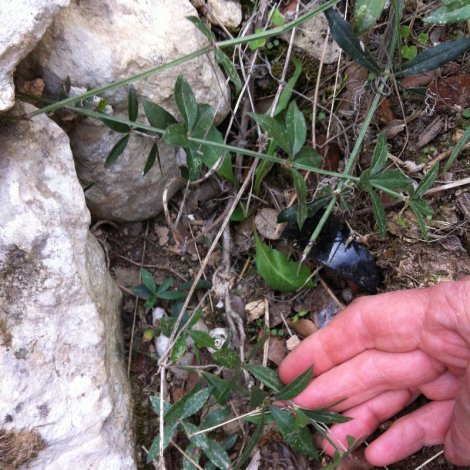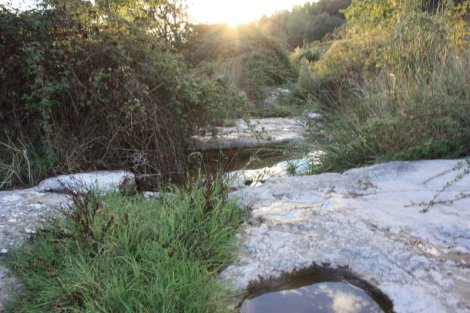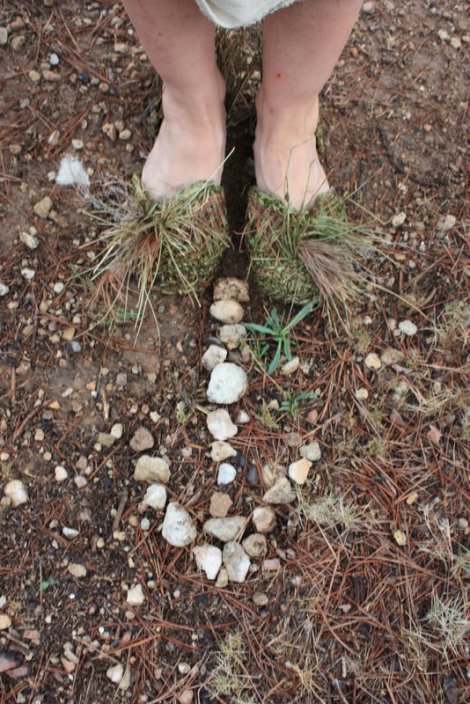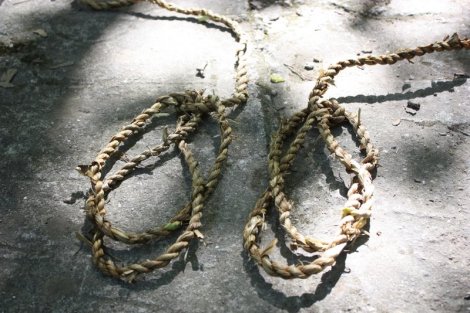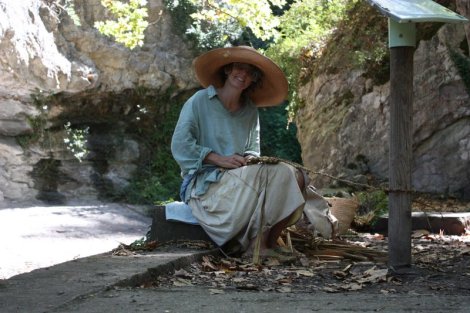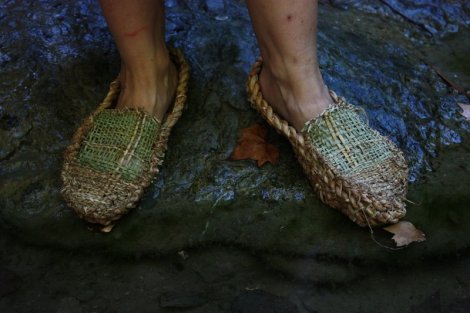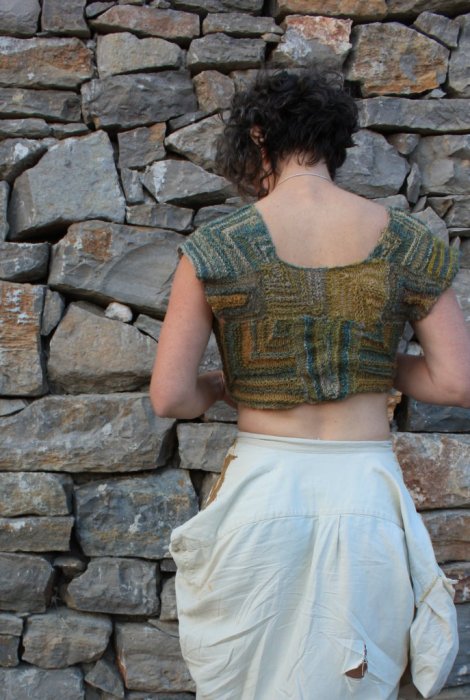It is a curious thing returning to a “foreign landscape”, a place away from home, but previously visited. Having been here at CACIS twice before to make work in collaboration with the land at the same time of year in 2010 and 2012, I feel I sort of know this place.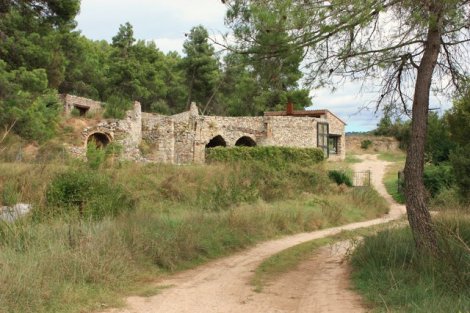
But as they say, you can’t go back- a place is never the same twice, just as one can’t stand in the same river twice- a different current always flows past.
What I find so fascinating this time is how I see the land as if for the first time, primarily because my own knowledge of plants has increased so much since the last time I was here. My (still growing) understanding of foraging for edibles, dye plants and weaving plants has impacted how I look and what I can now see far more then I had expected.
This is a great feeling I must admit and serves as an unexpected check-in on my ongoing research and skill gathering. Suddenly, the wild arugula EVERYWHERE shows itself, as does the fireweed ( which is ready for fibre harvest) an osier dogwood relative, milk thistle, 6 different mints, elderberry, kale- and even the first boletus mushrooms of the season ( which David knows, and keeps offering up in delicious meals). Hard pressed to say which plant I have been the most excited to discover- the arugula is so hot it blows my mind and I am addicted to it in the same way I can’t leave a bowl of wasabi peas alone- I pop arugula flowers in my mouth constantly as I walk. But, the fireweed, which has smaller flower heads here is very tall and the skin is ready to come off in long, strong strips allowing me for the first time to become familiar with thigh spinning two–ply, a wonderful chance to push my skill-set.
I think my best moments have been knowing the name of the plant Roser and Joan showed me when we were looking for dye plants for an upcoming workshop, Celandine, whose yellow toxic latex offers up a strong yellow dye and grows weed-like around the house. And then, best moment of all… poking at the ground with David around a plant that triggered a memory but I hadn’t placed until I saw the roots and strongly suspected it was madder, a quick dye test proved me right!
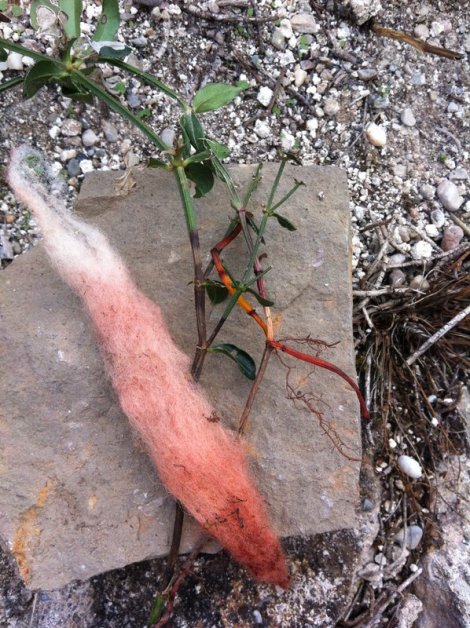 Suddenly I was seeing madder everywhere. Both madder and celandine I am familiar with because I am lucky enough to have a friend and colleague at home, Robin Ripley, who is a gardener and an artist- and Robin has been transplanting some plants from her garden to Means of Production Garden that she thinks we might be able to use, and helping me source plants and choose locations for others. A young madder we planted last fall will not be ready for harvest until likely 2019, and even then in small amounts- so no wonder my “discovering” it abundantly wild and the chance to play with it here is so exciting.
Suddenly I was seeing madder everywhere. Both madder and celandine I am familiar with because I am lucky enough to have a friend and colleague at home, Robin Ripley, who is a gardener and an artist- and Robin has been transplanting some plants from her garden to Means of Production Garden that she thinks we might be able to use, and helping me source plants and choose locations for others. A young madder we planted last fall will not be ready for harvest until likely 2019, and even then in small amounts- so no wonder my “discovering” it abundantly wild and the chance to play with it here is so exciting.
All of these walking and foraging trips are a part of both research and gathering for weaving.
The project I am working on is both the physical marker of a compass installation, and a performative action- a meditative rumination if you will– on my walking this land in the four compass directions from the studio.
Four pairs of shoes are being made, each made with materials harvested while walking specifically in one direction. In my first days here in 2010 I was struck by how different the landscape was depending on which direction one walked. I will come back to the shoes but first let me describe this place from the perspective of the four directions.
The Land:
North of me is a pine forested hillside with rows of old terraced walls, juniper and rosemary bushes serve as mid-level size bushes while thyme, lavender and various grasses are under foot. The smell is divine. Heading into the town of Artes for groceries involves heading North, cutting through the woods for shelter from the sun. It is the direction the barraca de vinya, my first sculpture here, and the place I spent time in the heat of day on my first visit.

the northern forest, as documented in 2010 with barraca sculpture and actual barraca de vinya in background…
The Western direction offers either a main road or a river that leads to la font de las tapias- a special place that almost defies description and was introduced to me by my host back in 2010. Known as The Source it is a place with clean pure water flowing into a small, cold pool where three large fish I think are trout live. The pool is about 30 meters down from a rock wall that surrounds it on 3 sides, a wall covered in dripping vines, ferns and lush with green. A large fig tree hangs over the pool and the surrounding walls have deep undercuts big enough a small group of people could shelter from storms when needed. It feels old, as if it has been at the centre of survival and life for as long as humans have been here. Hand built rock walls and cut stone at the water’s edge speaks for me to attempts at controlling the water and even scrubbing clothes in Roman times- it is easy to build historical fantasies of what might have happened here in the distant past.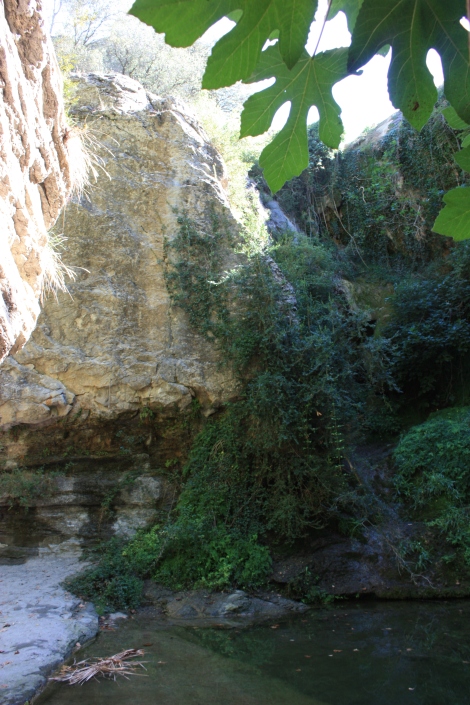
There are many routes we can take to The Source, the road is an easy direct walk best when carrying gear, but cutting in and out of the river’s trail on the smooth rocks allows for harvesting cattails, tulle and fireweed, and walking this feels like being on, or a part of, a massive ready-made sculpture.
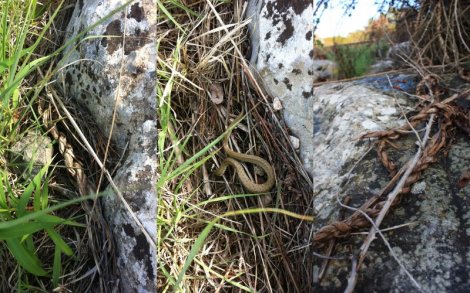
surprises include discovering remnants of my 2012 work blending in with snakes still quiet before the sun warms them in the early morning
Last trip we didn’t spent much time at the Source, a wild boar carcass was rotting not too far from the pool, having fallen off the cliff no doubt, it left a somewhat depressing air of mortal awareness hovering over the place. Eventually the carcass was dragged off by something and likely eaten but the memory was fresh and as a result I think we didn’t lounge here. But Las Tapias became our out-studio for the better part of a week this year.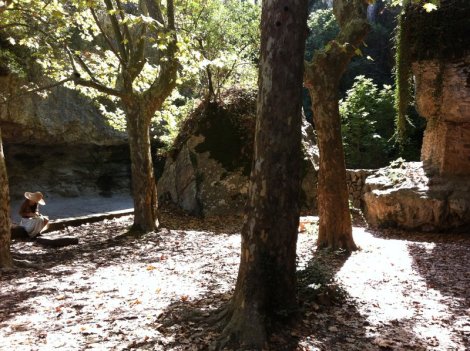 For the first time I was brave enough to embrace swimming here, not letting the cold intimidate me, but rather seeing it as a cooling opportunity. Many quick repeated skinny dips have been luckily timed between locals coming down with their dogs and an odd game of fetch has transpired only David and I know about. Locals throw massive sticks in for the dogs to retrieve, but usually dogs leave them in the water. I go in after everyone leaves and pull the sticks out- they get in the way of my back stroke so I am the one who drags the old branches to shore. The sticks work nicely too for holding my materials down that I soak in the pool in preparation for weaving. The plants I have foraged along the western route include yucca from the front gates of the property and tulle, cat tail, fireweed which grow all along the trail.
For the first time I was brave enough to embrace swimming here, not letting the cold intimidate me, but rather seeing it as a cooling opportunity. Many quick repeated skinny dips have been luckily timed between locals coming down with their dogs and an odd game of fetch has transpired only David and I know about. Locals throw massive sticks in for the dogs to retrieve, but usually dogs leave them in the water. I go in after everyone leaves and pull the sticks out- they get in the way of my back stroke so I am the one who drags the old branches to shore. The sticks work nicely too for holding my materials down that I soak in the pool in preparation for weaving. The plants I have foraged along the western route include yucca from the front gates of the property and tulle, cat tail, fireweed which grow all along the trail.
The Southern Direction is towards a distant farmer’s field, but before that and slightly East is the back yard for the private residence on the property. This direction includes the small back yard veggie garden, a number of fig trees, a massive lemon verbena bush I harvest from for iced tea, Arugula everywhere, and the zone from which I harvested another verbena variety as the main plant for the barraca sculpture. Other plants in this area include an impenetrable wall of papyrus, vitalba vine and prickly blackberry, fennel bushes, walnut and prune trees the celadinia, the almez- a nut bearing tree and the osier dogwood family bush is here too. I don’t spent a great time working in this area, as I feel myself encroaching on my hosts’ space, I forage quietly and head back to the studio instead.
Close at hand directly East is the old lime quarry, mined for a few hundred years as I understand it (the house at the quarry edge is 400 years old). A local sign as we interpret it states there was “activity on site” here dating back 1000 years. It is a large, flat open space surrounded by the cut rock wall. A hot place to spend time in the day, it is best explored in the evening, the last few hours before sunset. A field of arugula, tulle, clover, blackberry, lichen, rosemary, thyme and fennel. Further East out of the quarry a road leads off the property and passes beside farmed land, currently a fallow field with kale and lambs quarters growing everywhere, a sharp edge divides this plot from the recently tilled land beside- just turned over with manure spread- now looking like a perfect Zen garden with the furrow lines. The next rain will bring up “the Smell”, but presently it is just pleasing seeing those lines roll over the contours of the land.
The Shoes:
North- the first shoes made, mostly with the long unidentified round-stalk grasses readily available, pine needles that are rather short woven into the tops, and various dried flower stalks and skeletal leaves stick out, the shoes are like dance slippers, twined on the vintage shoe lasts I brought from home, with spiky tops and seed heads around the ankles allowing the shoes to camouflage in the forest. They feel sprite or fairy like…I think I need to dance on the rock walls in these…..
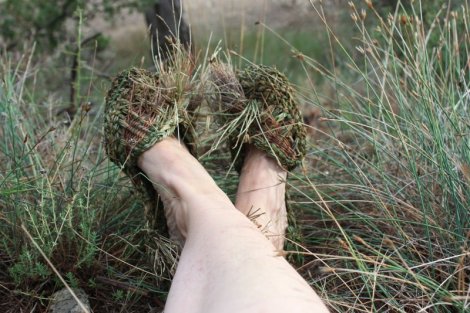 South- Being close to the house, I wanted the shoes for this direction to feel domestic, like house slippers and so chose a sort of roman-style slip on. I also wanted to make a fast pair of shoes, something as a part of my research for both future workshops or quick ‘shoe-need’ projects.
South- Being close to the house, I wanted the shoes for this direction to feel domestic, like house slippers and so chose a sort of roman-style slip on. I also wanted to make a fast pair of shoes, something as a part of my research for both future workshops or quick ‘shoe-need’ projects.
The papyrus leaves are what I mostly used, making rope from the dead, naturally retted leaves, then rigging up a back-strap loom with the rope in a manner based on what Rebecca Graham showed me she was doing- a method traditionally used for making the soles of Japanese sandals. I was able to quickly weave in the shoe base, then bring left-over rope up and around my foot in a method that holds the shoe on and makes it relatively comfortable for walking.
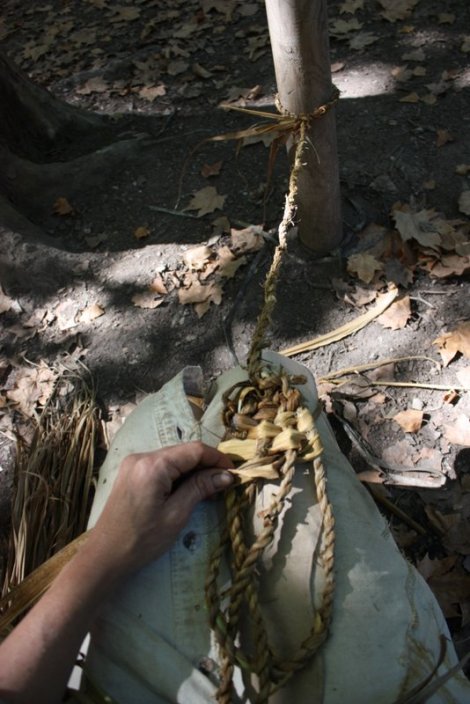 With each shoe I make I feel this revelation that I am somehow connecting with both my peers at home that have been a part of my learning process and past makers from antiquity- problem solving basic issues like how to protect the sole of my foot using what I find around me. How to hold my foot in such a way, following both the anatomy of my foot and the ergonomics of its flexibility.
With each shoe I make I feel this revelation that I am somehow connecting with both my peers at home that have been a part of my learning process and past makers from antiquity- problem solving basic issues like how to protect the sole of my foot using what I find around me. How to hold my foot in such a way, following both the anatomy of my foot and the ergonomics of its flexibility.
West- Something smooth to mimic the rocks, and good walkers I felt were needed here. I was inspired by looking at David’s moccasins that he wears around the apartment, and deconstructed this pattern very successfully into a woven shoe sole made with diagonally woven old yucca stalks, cat tail cordage coiled sides and plain weave and twined top vamps using yucca and tulle are sew together with two ply fireweed cordage. The inner seam is lined with cattail seed fluff, a soften edge for my foot.
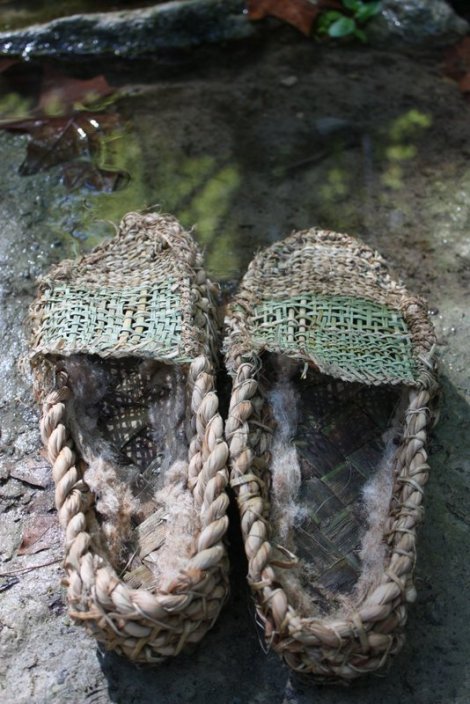 East-this pair is the last to be made- still just a concept, but the gathering has started and dried kale stalks, fennel and tulle form the basis for my weaving….
East-this pair is the last to be made- still just a concept, but the gathering has started and dried kale stalks, fennel and tulle form the basis for my weaving….
The idea of shoes as a sculptural metaphor worthy of exploring first began for me about a decade ago. My history of being a shoe hound began when I was fifteen and saved up at my $1.85/hr waitressing job to buy the red Italian $175.00 (sale price in 1985!) boots I lusted over and HAD TO HAVE… and eventually did, wearing them well into my thirties when I knew it was finally, sadly, time to say good by.
For the record let’s just state now I have a habit of buying expensive, well made foot wear. Shoes that double as sculpture- but that are always comfortable, and most pairs I own I wear and resole until the shoes if they were human would be of legal drinking age….I have hard to fit feet, a long narrow foot, with a large big toe and steep-sloped top profile made 80’s pointed-toe styles my best friends for decades. Saying I like shoes is an understatement, but I am very choosy, and a new pair comes home only every few years when an old pair is past resuscitating.
My recent return to making footwear- and this time wearable- was urged on in the urban cloth project, working with Tracy Williams and Mirae Rosner, making sandals with dancers, and then having fun with Rebecca as our research tangent continued. Rebecca in her recent blog post on her own shoe show held this past summer summed up beautifully how shoes as protection from the elements are a metaphor for our relationship with nature- and the need to protect ourselves from nature.
The idea of a layer between ourselves and the world- our shoe is our first form of defense, and also our most basic layer of disconnect from our surroundings- that layer of rubber, plastic, leather, vinyl- what have you-usually something synthetic- separates us from where we stand.
Somehow, as a performative action to getting to know this place- as a way of trying to further connect with this place- I felt a need to remove the barrier my street shoes provide, but also to use the ‘object/fetish nature’ of a shoe as a weaving challenge that would direct my making, my fibre choices and perhaps even how I step on the land. How thick is the sole? How fragile/strong is the plant it is made from? How long will it last before it wears out?
A walk as a durational performance will happen when the shoes are all done, with others welcome to join in and experience this with me the only pre-req being feet size 38/39…. and while all this happens I continue to knit my Vancouver linen, a new top will come home with me while the shoes stay behind- where they belong- to return the land.

